
Understanding Three-Way Communication
The Foundation of Three-Way Communication Model
Understanding the core principles of the three-way communication model is essential in enhancing team dynamics and workplace safety. This model involves three critical roles: the message sender, the message receiver, and the feedback provider. It encircles a continuous loop where the sender relays a message to the receiver, who is then expected to respond back to the sender, providing feedback and confirming understanding. This model demands that participants possess effective communication skills to ensure that messages are clear and concise. If a message isn't comprehended, the repeat process becomes necessary until the message is understood by both parties. This continuous dialogue enhances human performance and can improve communication outcomes significantly. Verbal communication accuracy is crucial in this model. It requires responsibilities from both the sender and the receiver to engage thoughtfully. The message sender should aim at providing well-structured messages, while the communication sender should receive feedback actively. Safety in the workplace can be improved through this three-pathway process by offering a platform for open dialogue, ensuring that all employees feel their voice is heard in the context of team settings. Each person involved plays a significant role in driving effective communication, ultimately fostering an environment where privacy policies are respected, and messages are conveyed effectively. For a deeper understanding of the interplay between these roles and how power dynamics can influence the communication process, consider exploring the dynamics of power in team settings here.The Role of Feedback in Three-Way Communication
The Crucial Function of Feedback in Three-Way Interaction
To truly harness the power of three-way communication, feedback must take its rightful place at the center of the communication process. Here's why feedback is essential: First, it serves as the backbone of the communication model by ensuring that the intended message is fully understood by the receiver. This process involves not just receiving messages but actively confirming the clarity and essence of the message sent by the sender. Because communication is not linear, feedback allows for the sender to know their message has reached the receiver, promoting understanding and preventing miscommunication. Furthermore, incorporating feedback in communication creates a loop that bolsters workplace safety and human performance. Employees, through verbal exchanges, can express their thoughts and concerns, enabling management to act on these feedbacks effectively. This makes the three-way communication model a potent tool in workplace settings, as it fosters an environment where safety and effective work go hand in hand. Moreover, feedback in three-way communication encourages a culture of open dialogue where employees feel their input is valued, improving their engagement and motivation. This can also enhance the overall communication skills of team members, leading to effective communication that is clear, concise, and actionable. Through repeated feedback loops, teams can refine their communication process, thus honing their skills in delivering messages accurately and conveying context efficiently. By prioritizing feedback, teams can create a dynamic where the message sender, as well as the message receiver, can seamlessly interact, minimizing misunderstandings and optimizing teamwork. For further insight into the feedback mechanisms within complex processes, you can explore the dynamics of the PMP process mapping game, which highlights practical applications in management communication models. This integration of feedback within the three-way communication process contributes significantly to improving performance and boosting workplace morale.Implementing Three-Way Communication in Teams
Implementing Successful Communication Strategies for Teams
In the journey of enhancing team dynamics through three-way communication, it's essential to focus on the implementation of effective strategies in the workplace. This process is not just about using the right models of communication but also ensuring the message is clear and understood by the message receiver.- Start with a Clear Structure: For three communication processes to be effective, building a clear and concise communication model is fundamental. This involves the message sender conveying the information in a structured way, the message receiver actively listening, and feedback being provided promptly. The loop ensures the message is fully understood and allows for adjustments if any gaps or miscommunications arise.
- Create a Safe Communication Environment: Workplace safety isn’t just about physical well-being but also mental comfort. Establishing a space where employees feel safe to express their thoughts and feedback is crucial. This could be fostered through regular check-ins or team-building activities designed to enhance communication skills, thus making verbal communication less daunting.
- Leverage Feedback Wisely: Feedback plays a pivotal role in the communication process, acting as a bridge between sender and receiver. It’s essential to view feedback not as criticism but as a tool for improvement. Encouraging an environment where feedback is welcome can significantly improve communication among team members, leading to enhanced performance.
- Utilize Technology to Aid Communication: Modern workplaces benefit from a myriad of tools designed to improve communication. From radios to advanced communication software, utilizing these tools can ensure that messages are conveyed effectively and efficiently. However, it's crucial to balance this with verbal communication to maintain a human touch.
- Repeat the Process: As with many strategies, consistency is key. Regularly engaging in three-way communication practices ensures that all parties involved become more adept at conveying messages, interpreting them, and providing feedback. This repetition cultivates an environment where communication becomes a natural and fluid process.
Overcoming Challenges in Three-Way Communication
Addressing Miscommunication and Misinterpretation
One of the primary challenges in three-way communication is ensuring that the message is accurately conveyed and understood by all parties involved. The sender must craft a clear and concise message, while the receiver needs to interpret it correctly. Miscommunication often arises when the context is not fully considered or when assumptions are made about the receiver's understanding. To mitigate this, it's crucial to establish a feedback loop where the receiver can confirm their understanding, allowing the sender to clarify any ambiguities.
Ensuring Privacy and Safety in Communication
Another challenge is maintaining workplace safety and privacy during the communication process. In environments where sensitive information is shared, such as in radio communications or verbal communication in open spaces, it's essential to have protocols that protect the message from unintended recipients. Implementing a privacy policy and ensuring that all employees are trained in effective communication skills can help in safeguarding the information.
Overcoming Barriers to Effective Communication
Barriers such as noise, distractions, or even cultural differences can impede the communication process. To improve communication, teams should focus on creating an environment conducive to effective communication. This includes minimizing distractions, using models of communication that suit the team's dynamics, and encouraging open dialogue where every person feels comfortable to communicate effectively.
Enhancing Human Performance Through Communication
Finally, the ultimate goal of overcoming these challenges is to improve human performance. By ensuring that messages are understood and that the sender-receiver dynamic is optimized, teams can enhance their overall performance. This involves a continuous effort to repeat the process of refining communication strategies and ensuring that all messages are effectively transmitted and received.
The Impact of Three-Way Communication on Team Dynamics
Unleashing the Power of Three-Way Communication in Team Interactions
In the workplace, effective communication is the backbone of successful team dynamics. Three-way communication, with its sender-receiver-feedback model, provides a solid foundation for fostering a collaborative and responsive work environment. Here are some key impacts:- Improved Understanding: By ensuring messages are clear and concise, leaders can mitigate misunderstandings. This verbal communication process allows both the message sender and the receiver to confirm content, context, and intent, thereby ensuring the message understood is accurate.
- Enhanced Feedback Loops: Feedback plays a critical role in refining messages and improving communication skills. It allows for repeat processes where employees can continuously refine their approach, leading to greater human performance.
- Boosted Workplace Safety: In industries where safety is paramount, three communication methods help secure the work environment. The ability to communicate effectively about safety procedures and receive timely feedback ensures that employees feel secure and informed.
- Increased Performance: Effective communication paves the way for high-performing teams. It empowers all parties involved—the person sending the message, the communication receiver, and those providing feedback—to maintain a productive dialogue. This leads to enhanced white-collar efficiency and effectiveness in project tasks.
- Stronger Team Dynamics: Teams that utilize effective three-way communication develop robust connections as they adapt to the communication process. Models communication, such as radio calls in high-risk sectors, spotlight the importance of the sender receiver dynamic in maintaining team cohesion.
Case Studies: Success Stories of Three-Way Communication
Success Stories Illustrating Three-Way Communication's Impact
When we evaluate real-world examples of successful three-way communication, it becomes evident how this approach enhances workplace dynamics. These cases underline the tangible benefits, from improved performance to increased workplace safety.- Improving Human Performance through Clarity
- A leading tech company faced challenges with message misunderstanding across departments. By implementing a three-way communication model, they ensured that every message sender confirmed the message received and understood by the message receiver. This feedback loop helped reduce errors and enhance effective communication, leading to a notable improvement in human performance.
- Fostering Workplace Safety in Manufacturing
- A manufacturing plant adopted the three-way communication process to boost workplace safety. Employees were encouraged to repeat the process, where verbal communication was corroborated with feedback to confirm task instructions were accurately received and executed. The outcome was a significant decrease in workplace accidents as messages were clear and concise, cultivating a culture of safety alongside operational efficiency.
- Enhancing Team Synergy in Cross-Cultural Settings
- In a multinational corporation, teams from diverse cultural backgrounds faced barriers in communication. By using the sender-receiver model, they utilized three communication strategies that included feedback from a third person to bridge cultural differences. This approach ensured that all parties involved understood the context of messages, thereby improving synergy among employees who otherwise struggled with verbal communication nuances.












